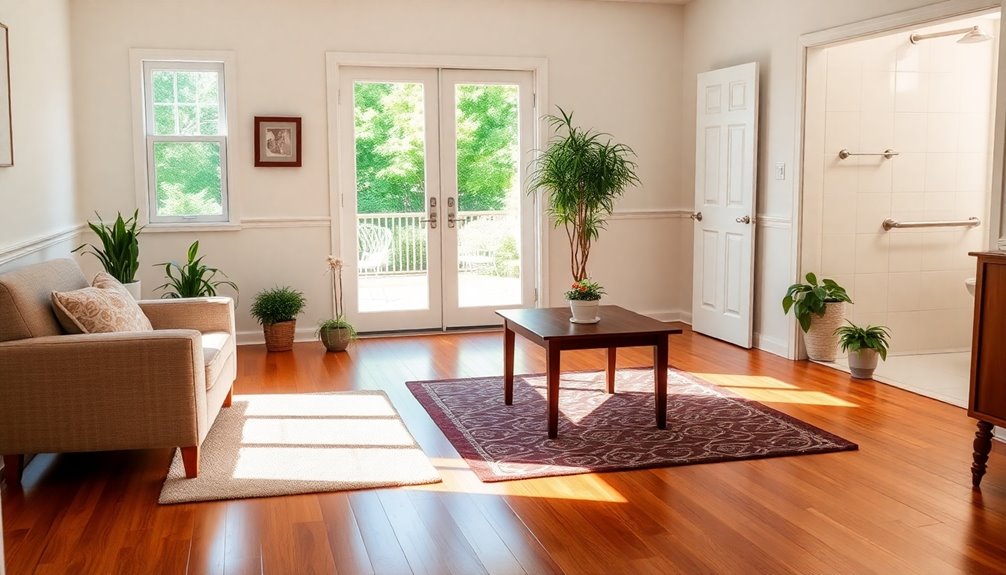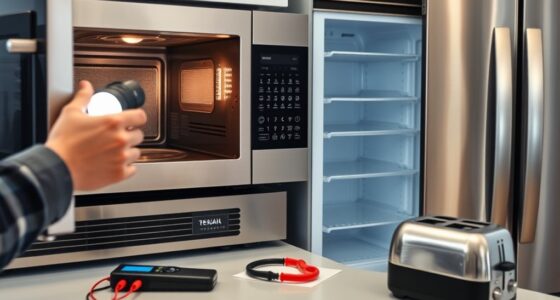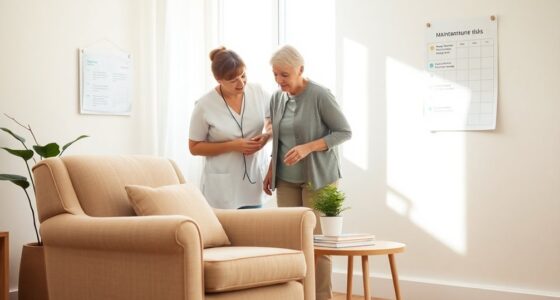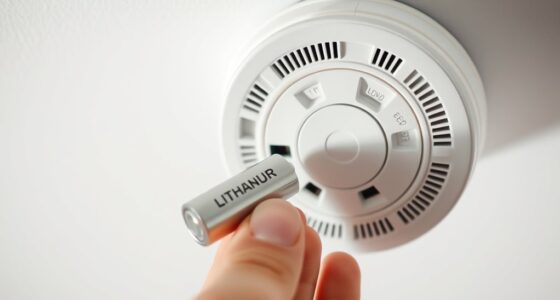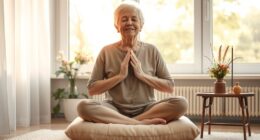To prevent accidents in elderly homes, keep emergency numbers handy and guarantee adequate lighting throughout. Regularly clear clutter to improve navigation and install grab bars and handrails for added support. Prevent falls by using non-slip mats and footwear, and avoid bathroom hazards with safety enhancements. Protect against fire by maintaining smoke detectors and checking appliance cords. Finally, monitor for signs of abuse and educate seniors to recognize potential dangers. Discover more essential tips to enhance safety! Additionally, ensure that furniture is arranged to create clear pathways, making it easier for seniors to move around without obstruction. Regular safety audits of the living space can help identify and address potential risks early. For more comprehensive strategies, consider exploring additional tips for elderly safety maintenance to further safeguard their well-being.
Key Takeaways
- Regularly assess and maintain balance-enhancing grab bars in bathrooms and stairways for added support and safety.
- Keep hallways and common areas well-lit and free of clutter to prevent tripping hazards.
- Use non-slip mats in bathrooms and ensure floors are dry to reduce slip risks.
- Install smoke detectors and check their functionality biannually to enhance fire safety.
- Secure cleaning supplies and medications in locked cabinets to prevent accidental poisoning.
Keep Emergency Numbers Handy
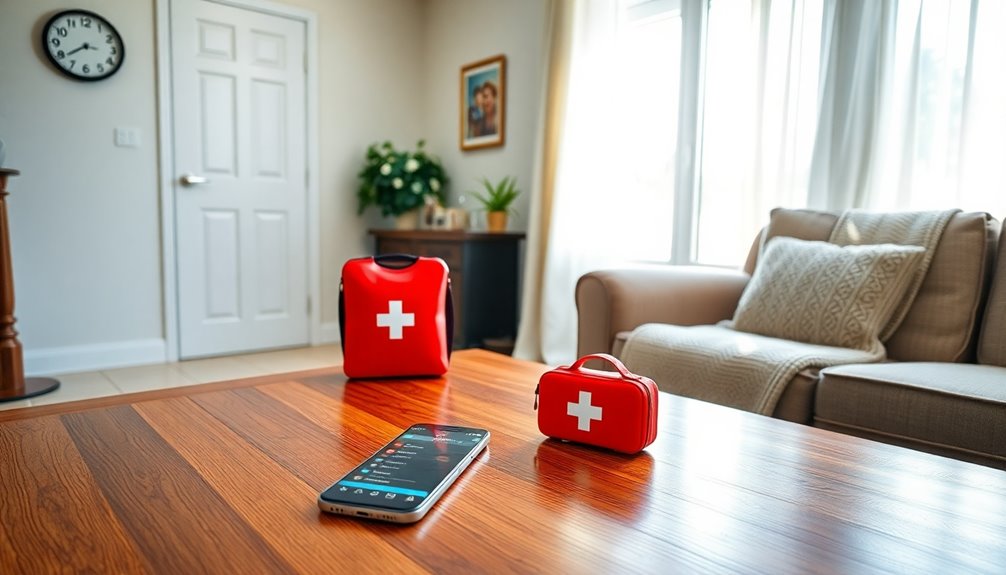
In case of an emergency, having quick access to important numbers can make all the difference. Post a list of emergency numbers, including 911 and Poison Control (1-800-222-1222), in large print near each phone.
Don't forget to add essential family members' contacts and your healthcare provider's office number, ensuring you can reach them immediately during a crisis.
Regularly update this emergency contact list to keep it accurate, reflecting any changes in phone numbers. Place these numbers in visible spots, like on the refrigerator or near the front door, for easy retrieval.
Encourage family members and caregivers to familiarize themselves with the list—this enhances everyone's readiness and response time when it comes to critical home safety tips.
Prevent Falls

To prevent falls, you should assess your balance regularly and make necessary adjustments.
Installing grab bars in key areas, like the bathroom, can provide essential support, while non-slip footwear helps keep you steady on your feet.
Taking these steps can greatly reduce your risk of falling at home. Additionally, the importance of long-term financial planning for assisted living needs can help ensure that necessary safety modifications are made in a timely manner.
Assess Balance Regularly
Regular evaluations of balance are crucial for preventing falls in elderly individuals.
You should consult a healthcare provider for a falls risk evaluation, which can help identify any balance issues and recommend appropriate interventions. Engaging in exercise programs designed to enhance strength and balance can greatly reduce the risk of falls.
Also, consider using wearable alarms that alert emergency services in case of a fall, adding an extra layer of safety. Ascertain that walking aids like canes or walkers are easily accessible, especially at night, to avoid mobility challenges.
Encourage seniors to wear non-slip footwear indoors to minimize slipping on smooth surfaces, a common cause of falls.
Regularly evaluating balance is a proactive step in securing safety.
Install Grab Bars
Evaluating balance is just one part of creating a safer environment for seniors.
Installing grab bars in key areas, such as inside and outside of showers, tubs, and next to toilets, can greatly reduce the risk of falls, a common accident for older adults.
Make sure to securely mount grab bars to wall studs to support at least 250 pounds, ensuring they won't fail during a fall.
Aim for a height of 33 to 36 inches from the floor for easy accessibility.
Opt for grab bars made from slip-resistant materials to enhance grip, especially in wet areas.
Don't forget to regularly check for any signs of wear or looseness, as proper maintenance is essential for their effectiveness in preventing accidents.
Utilize Non-Slip Footwear
Choosing the right footwear is vital for enhancing safety at home, especially for seniors. Non-slip footwear markedly reduces the risk of falls, which are a leading cause of injury among older adults.
With nearly one-third of seniors experiencing falls each year, it's important to prioritize grip on smooth surfaces. Opt for shoes with a flat sole and cushioned footbed to enhance stability and comfort, particularly on uneven flooring or around obstacles.
Avoid wearing socks or slippers on smooth floors, as they can increase slipping risks. Instead, choose shoes designed for indoor use with non-slip soles.
Regularly check the condition of these shoes, replace worn-out pairs, and confirm they fit well to maintain safety and mobility in your home. Additionally, consider designating pet-free zones in areas where seniors frequently walk to further reduce the risk of falls caused by pet hair.
Safety-Proof Your Home

Making your home safe is essential for the well-being of elderly residents. You can greatly reduce tripping hazards and enhance overall safety by taking a few simple steps.
Make sure that hallways, stairs, and paths are well-lit and free of clutter. Secure area rugs with tape to prevent slipping, as they often contribute to falls.
Here are some quick tips to help you safety-proof your home:
- Keep frequently used items within reach to minimize unnecessary movement.
- Regularly inspect for hazards like frayed cords or loose floorboards.
- Install grab bars and handrails in bathrooms and stairways for added support. Additionally, consider understanding the emotional and social impact of making a home safe, as it can lead to a more secure environment for elderly residents.
Protect Against Fire and Related Dangers

When it comes to protecting elderly residents from fire and related dangers, taking proactive measures can make all the difference.
Start by installing smoke detectors in key areas of the home environment and replace their batteries biannually to guarantee they're always functional.
Evacuating immediately during a fire is essential; seniors shouldn't attempt to extinguish flames themselves due to slower reaction times.
Encourage fitted clothing while cooking to reduce fire hazards, as loose sleeves can catch fire easily.
Regularly inspect and replace any frayed appliance cords to prevent electrical fires.
Finally, limit the number of electric cords plugged into a single socket to avoid overload, which can lead to overheating and potential fire outbreaks.
Avoid Bathroom Hazards
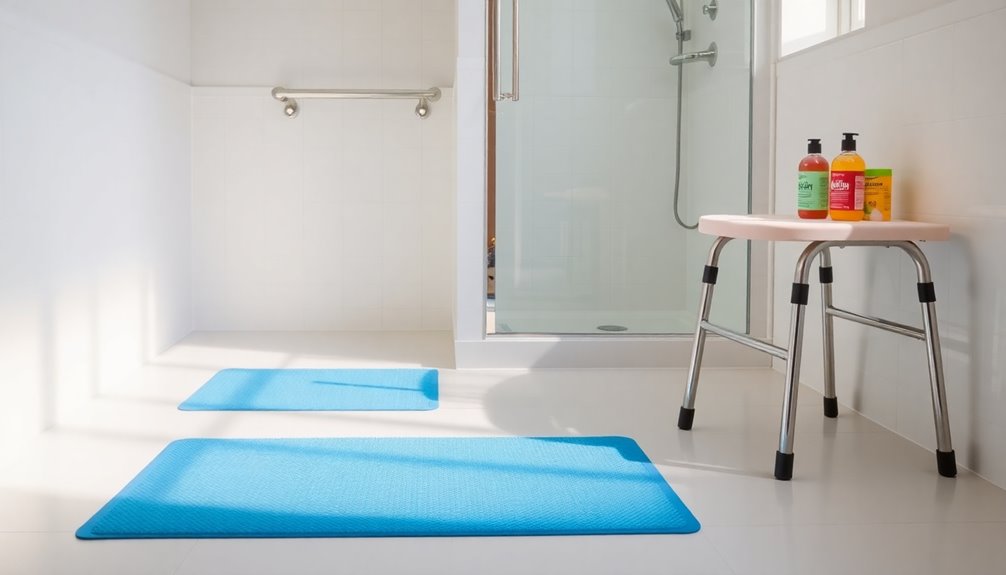
To keep the bathroom safe, you should install grab bars in the shower and near the toilet for added support. Using non-slip mats can help prevent dangerous slips, while keeping the floors dry minimizes fall risks. Additionally, consider upgrading the lighting to ensure bright illumination during nighttime visits, enhancing visibility and safety.
Install Grab Bars
Installing grab bars in your bathroom can greatly enhance safety, especially for seniors maneuvering slippery surfaces.
These sturdy supports provide essential assistance for those with limited mobility when entering and exiting bathtubs and showers.
- Make sure grab bars are securely mounted and can support at least 250 pounds.
- Position them 33 to 36 inches above the floor to suit various heights.
- Regularly check for stability and rust to maintain their effectiveness.
Use Non-Slip Mats
Non-slip mats are essential for preventing bathroom accidents, especially for seniors. They markedly reduce the risk of slips and falls, which account for nearly 70% of falls in the home. Choose mats made of rubber or traction-specific materials, guaranteeing they stay put even when wet. Always pick mats with drainage holes to avoid water accumulation. Regularly inspect these mats for wear and tear, replacing them when necessary to maintain bathroom safety. Combining non-slip mats with grab bars can further enhance safety. Additionally, using mats designed for enhanced traction can significantly improve stability for those with mobility challenges.
| Feature | Importance | Recommendation |
|---|---|---|
| Material | Provides traction | Choose rubber or traction materials |
| Drainage Holes | Prevents water pooling | Opt for mats with holes |
| Inspection | Guarantees effectiveness | Check regularly |
| Combination | Enhances safety | Use with grab bars |
Keep Floors Dry
Keeping bathroom floors dry is essential for preventing slips and falls, especially for seniors who are more vulnerable to accidents.
Wet surfaces considerably increase the risk of falls, which is a leading safety concern for seniors living independently.
Here are some quick tips to help you keep floors dry:
- Regularly check for leaks or spills and clean them immediately.
- Use non-slip mats in the bathtub and shower to reduce slippery surfaces.
- Maintain adequate lighting to help navigate safely.
Additionally, consider installing grab bars near bathtubs and toilets for extra stability.
Prevent Poisoning
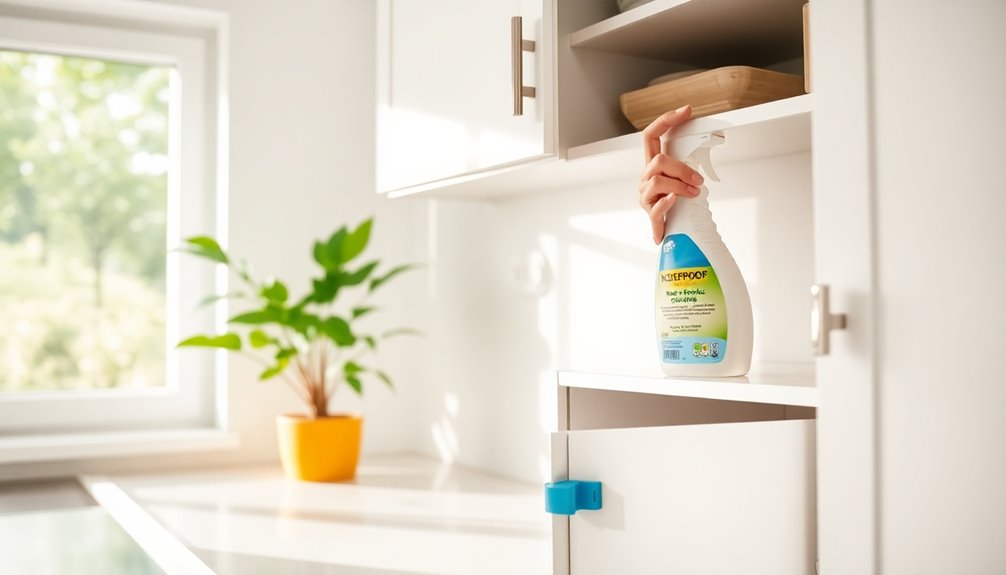
To prevent poisoning in elderly homes, it's essential to take proactive measures that safeguard seniors from hazardous substances.
Keep all cleaning supplies, medications, and toxic substances locked away and out of reach. Label household products clearly to help seniors identify harmful items easily.
Educate them about the dangers of mixing household chemicals, as this can lead to toxic gas exposure and poisoning. Installing child-proof locks on cabinets containing hazardous materials adds an extra layer of protection against accidental ingestion.
Regularly review and dispose of expired medications and substances to prevent accidental consumption of outdated or harmful products.
Protect Against Abuse
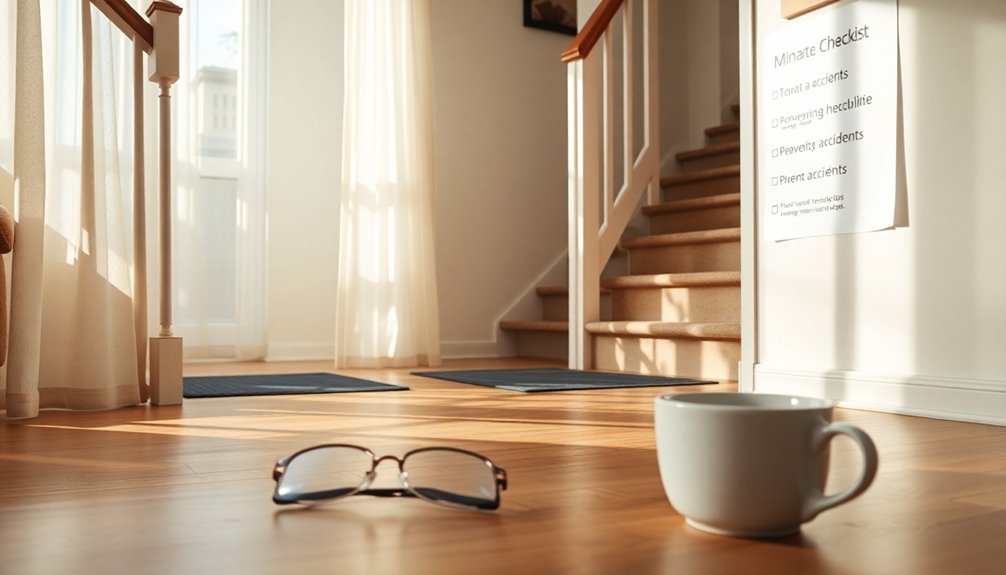
You need to be aware of the signs of elder abuse, as recognizing them can make a big difference in your loved one's safety.
Encourage open communication so that seniors feel comfortable sharing their concerns with you.
Recognize Signs of Abuse
How can one guarantee the safety and well-being of elderly loved ones? Recognizing signs of abuse is vital. Elder abuse affects about 1 in 10 seniors, so vigilance is key.
Watch for unexplained injuries, bruises, or frequent hospital visits—these might indicate physical abuse. Emotional abuse can show up as withdrawal or sudden behavior changes. Financial exploitation often reveals itself through unexplained withdrawals or lack of basic necessities despite having funds.
- Trust your instincts; if something feels off, it probably is.
- Stay observant of your loved one's behavior and environment.
- Regularly check in on their financial matters.
Additionally, be aware that chronic feelings of emptiness can sometimes lead to vulnerability in elderly individuals, making them more susceptible to abuse.
Always report anything suspicious to the appropriate authorities to protect your loved one from harm.
Encourage Open Communication
While fostering an environment of open communication may seem challenging, it's essential for ensuring that aging loved ones feel comfortable discussing their concerns about abuse or neglect.
Regular check-ins and conversations can help them express their feelings, making it easier to identify potential abusive situations. Educating seniors about their rights and the signs of abuse empowers them to speak up and seek help if they're uncomfortable in their living situation.
Establishing a routine of open dialogue builds trust and encourages them to report troubling behaviors. Additionally, encouraging seniors to maintain social connections with friends and family can reduce isolation, increasing the likelihood they'll share experiences and seek assistance.
Together, these steps can create a safer living environment for your loved ones.
Establish Safe Environments
Creating a safe environment for elderly individuals is essential for protecting them from potential abuse and ensuring their overall well-being. To establish safe environments, consider these key steps:
- Conduct regular home assessments to identify hazards.
- Implement security measures like monitoring systems and emergency contact lists.
- Educate seniors on recognizing and reporting abuse.
Involving family members in these discussions can enhance supervision and support.
Additionally, creating a network of friends and community resources provides more oversight in daily activities. Furthermore, it is important to understand myths about divorce that may affect family dynamics, as these can impact the emotional well-being of elderly individuals in the home.
Remember to regularly review and update safety protocols and emergency services plans to adapt to changing needs.
Ensure Adequate Lighting
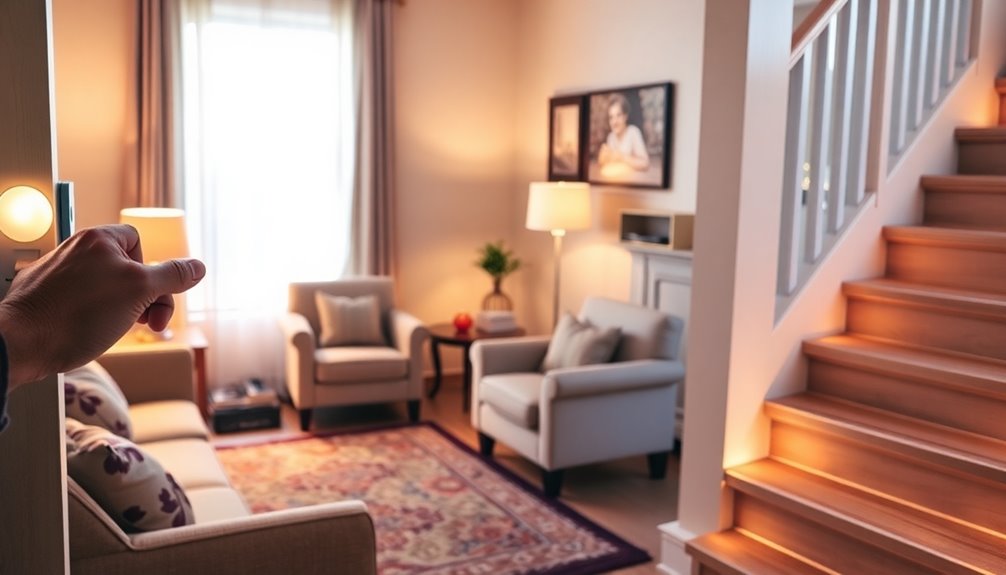
Ensuring adequate lighting in your home is essential for preventing falls and accidents, particularly for elderly individuals. About 70% of falls happen in poorly lit areas, making it vital to install additional lighting in hallways, staircases, and bathrooms.
These areas are common spots for accidents among seniors, so brightening them up can greatly enhance safety.
Using night lights is a great way to improve visibility during nighttime trips to the bathroom, helping to prevent mishaps.
Consider upgrading to glow-in-the-dark or illuminated light switches, which make locating switches easier in dim conditions.
Finally, regularly check and replace burnt-out light bulbs to maintain a well-lit environment.
Prioritizing these steps can create a safer home for seniors and reduce the risk of falls.
Clear Clutter for Navigation
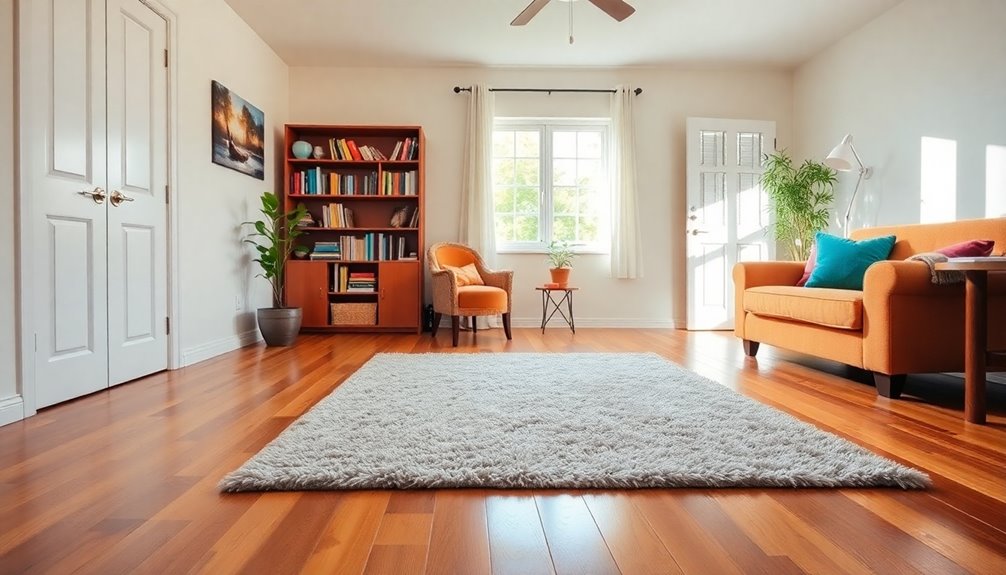
To navigate a home safely, it's crucial to clear clutter from walkways and common areas. Removing boxes, newspapers, and cords greatly reduces tripping hazards—one of the leading causes of falls among seniors.
By making small changes, like storing frequently used items within easy reach, you minimize the risk of seniors needing to climb or stretch.
Here are some tips to help you clear clutter effectively:
- Confirm clear pathways to light switches and exits.
- Keep homes brightly lit to enhance visibility.
- Position lamps within easy reach of beds and seating areas. Additionally, consider implementing best practices for organizing prep tables to further enhance safety in the home environment.
Install Grab Bars and Handrails
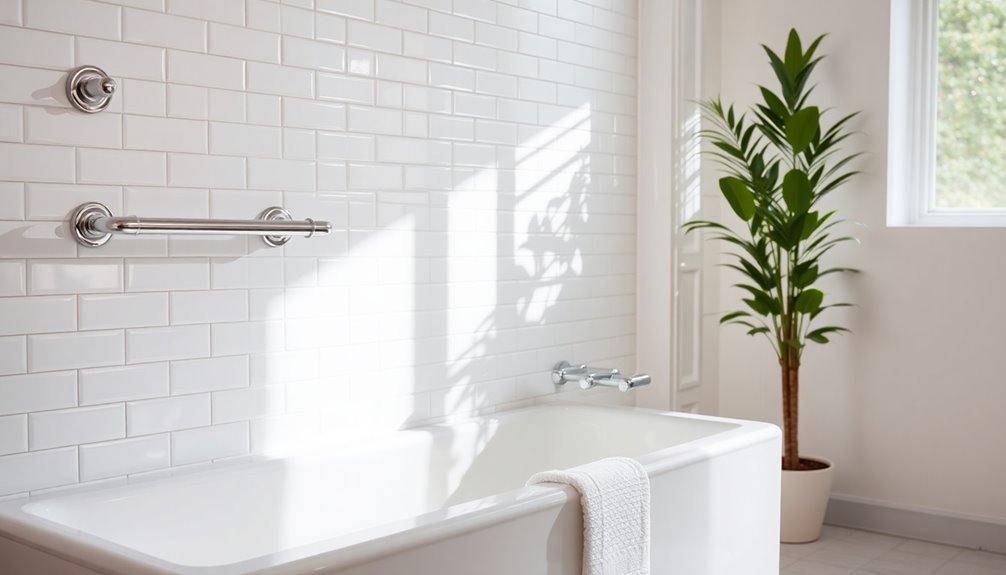
While falls can happen unexpectedly, installing grab bars and handrails in key areas of the home can provide essential support for seniors.
Place grab bars in bathtubs, showers, and near toilets, as nearly one-third of seniors experience falls in these areas. Position them at a height of 33 to 36 inches for easy access.
Handrails should be securely installed on both sides of stairways, offering vital support for maneuvering steps, which are common fall locations. To enhance safety, apply non-slip treads to bare-wood steps.
Regularly inspect grab bars and handrails for stability and wear to guarantee they function properly. Environmental interactions can also significantly impact an elderly person's ability to navigate their home safely.
Frequently Asked Questions
How Can Elderly Prevent Home Accidents?
To prevent home accidents, you should focus on creating a safe environment.
Start by installing grab bars in bathrooms and near stairs for support. Keep pathways clear of clutter and secure rugs to avoid tripping hazards.
Guarantee adequate lighting, especially in hallways and staircases, to improve visibility.
Also, regularly check smoke detectors and keep frequently used items within easy reach to minimize stretching or bending, reducing the risk of falls.
What Are the Safety Tips for Elderly People at Home?
To keep yourself safe at home, make certain your hallways and staircases are well-lit and clutter-free.
Install grab bars in bathrooms and near stairways for added support.
Regularly check your smoke detectors and keep emergency contact numbers handy.
Use non-slip mats in kitchens and bathrooms to prevent slips.
What Are the 7 Physical Needs of the Elderly?
As the saying goes, "An ounce of prevention is worth a pound of cure."
When considering the physical needs of the elderly, focus on mobility through regular exercise, guarantee they're eating a balanced diet rich in nutrients, and encourage hydration.
Address sensory perceptions by providing adequate lighting and minimizing noise.
Assist them with daily activities like bathing and dressing, and be mindful of their need for social interaction to maintain emotional health.
How Does a Caregiver Prevent Home Accidents?
To prevent home accidents, you should regularly assess the living environment for hazards.
Install grab bars in bathrooms and handrails on stairs to boost safety.
Keep emergency contacts visible and guarantee easy access to frequently used items in the kitchen, minimizing the need for stretching.
Regularly check smoke detectors and maintain adequate lighting throughout the home to avoid fire hazards and falls.
Your proactive approach can greatly improve safety for those you care for.
Conclusion
By following these ten essential maintenance tips, you can create a safer environment for your elderly loved ones, proving that "an ounce of prevention is worth a pound of cure." Keeping emergency numbers handy, ensuring adequate lighting, and preventing falls are just a few ways to protect their well-being. Remember, a little effort today can lead to a more secure tomorrow. Let's work together to keep our homes safe and nurturing for everyone!
